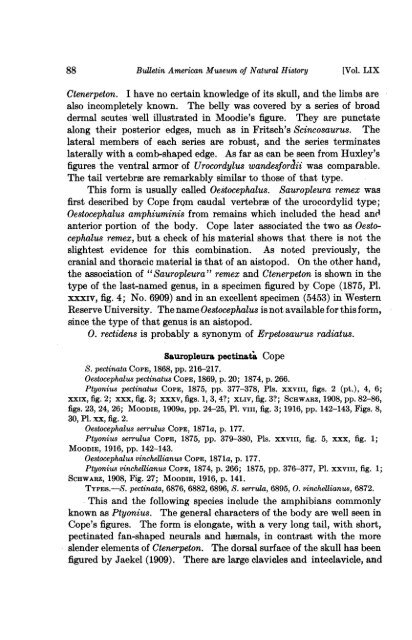View/Open - American Museum of Natural History
View/Open - American Museum of Natural History
View/Open - American Museum of Natural History
You also want an ePaper? Increase the reach of your titles
YUMPU automatically turns print PDFs into web optimized ePapers that Google loves.
88 Bulletin <strong>American</strong> <strong>Museum</strong> <strong>of</strong> <strong>Natural</strong> <strong>History</strong><br />
[Vol. LIX<br />
Ctenerpeton. I have no certain knowledge <strong>of</strong> its skull, and the limbs are<br />
also incompletely known. The belly was covered by a series <strong>of</strong> broad<br />
dermal scutes 'well illustrated in Moodie's figure. They are punctate<br />
along their posterior edges, much as in Fritsch's Scincosaurus. The<br />
lateral members <strong>of</strong> each series are robust, and the series terminates<br />
laterally with a comb-shaped edge. As far as can be seen from Huxley's<br />
figures the ventral armor <strong>of</strong> Urocordylus wandesfordii was comparable.<br />
The tail vertebrae are remarkably similar to those <strong>of</strong> that type.<br />
This form is usually called Oestocephalus. Sauropleura remex was<br />
first described by Cope frQm caudal vertebrae <strong>of</strong> the urocordylid type;<br />
Oestocephalus amphiuminis from remains which included the head and<br />
anterior portion <strong>of</strong> the body. Cope later associated the two as Oestocephalus<br />
remex, but a check <strong>of</strong> his material shows that there is not the<br />
slightest evidence for this combination. As noted previously, the<br />
cranial and thoracic material is that <strong>of</strong> an aistopod. On the other hand,<br />
the association <strong>of</strong> "Sauropleura" remex and Ctenerpeton is shown in the<br />
type <strong>of</strong> the last-named genus, in a specimen figured by Cope (1875, Pl.<br />
xxxiv, fig. 4; No. 6909) and in an excellent specimen (5453) in Western<br />
Reserve University. The name Oestocephalus is not available for this form,<br />
since the type <strong>of</strong> that genus is an aistopod.<br />
0. rectidens is probably a synonym <strong>of</strong> Erpetosaurus radiatus.<br />
Sauropleura pectinata<br />
Cope<br />
S. pectinata COPE, 1868, pp. 216-217.<br />
Oestocephalus pectinats CoPE, 1869, p. 20; 1874, p. 266.<br />
Ptyonius pectinatus COPE, 1875, pp. 377-378, Pls. xxviii, figs. 2 (pt.), 4, 6;<br />
xxix, fig. 2; xxx, fig. 3; xxxv, figs. 1, 3, 4?; XLIV, fig. 3?; SCHWARZ, 1908, pp. 82-86,<br />
figs. 23, 24, 26; MOODIE, 1909a, pp. 24-25, P1. VIII, fig. 3; 1916, pp. 142-143, Figs. 8,<br />
30,P1. x, fig. 2.<br />
Oestocephalus serrulus CoPE, 1871a, p. 177.<br />
Ptyonius serrulus COPE, 1875, pp. 379-380, Pls. xxviii, fig. 5, xxx, fig. 1;<br />
MOODIE, 1916, pp. 142-143.<br />
Oestocephalus vinchellianus COPE, 1871a, p. 177.<br />
Ptyonius vinchellianus COPE, 1874, p. 266; 1875, pp. 376-377, P1. xxviii, fig. 1;<br />
SCHWARZ, 1908, Fig. 27; MOODIE, 1916, p. 141.<br />
TYPES. S. pectinata, 6876, 6882, 6896, S. serrula, 6895, 0. vinchellianus, 6872.<br />
This and the following species include the amphibians commonly<br />
The general characters <strong>of</strong> the body are well seen in<br />
known as Ptyonius.<br />
Cope's figures. The form is elongate, with a very long tail, with short,<br />
pectinated fan-shaped neurals and haemals, in contrast with the more<br />
slender elements <strong>of</strong> Ctenerpeton. The dorsal surface <strong>of</strong> the skull has been<br />
figured by Jaekel (1909). There are large clavicles and inteclavicle, and
















